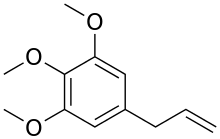Canarium luzonicum
| Canarium luzonicum | |
|---|---|
| Scientific classification | |
| Kingdom: | Plantae |
| Clade: | Angiosperms |
| Clade: | Eudicots |
| Clade: | Rosids |
| Order: | Sapindales |
| Family: | Burseraceae |
| Genus: | Canarium |
| Species: | C. luzonicum |
| Binomial name | |
| Canarium luzonicum | |
Canarium luzonicum, commonly known as elemi, is a tree native to the Philippines. The oleoresin harvested from it is also known as elemi.
Uses


Elemi resin is a pale yellow substance, of honey-like consistency. Aromatic elemi oil is steam distilled from the resin. It is a fragrant resin with a sharp pine and lemon-like scent. One of the resin components is called amyrin.
Elemi resin is chiefly used commercially in varnishes and lacquers, and certain printing inks. It is used as a herbal medicine to treat bronchitis, catarrh, extreme coughing, mature skin, scars, stress, and wounds. The constituents include phellandrene, limonene, elemol, elemicin, terpineol, carvone, and terpinolene.
History of the name
The word elemi has been used at various times to denote different resins. In the 17th and 18th centuries, the term usually denoted a resin from trees of the genus Icica in Brazil, and before that it meant the resin derived from Boswellia frereana. The word, like the older term animi, appears to have been derived from enhaemon (εναιμον): the name of a styptic medicine said by Pliny to contain tears exuded by the olive tree of Arabia.[2]
"The name Elemi is derived from an Arabic phrase meaning 'above and below', an abbreviation of 'As above, so below' and this tells us something about its action on the emotional and spiritual planes."[3]
See also
References
- ↑ World Conservation Monitoring Centre (1998). "Canarium luzonicum". The IUCN Red List of Threatened Species. IUCN. 1998: e.T33352A9779122. doi:10.2305/IUCN.UK.1998.RLTS.T33352A9779122.en. Retrieved 9 January 2018. Listed as Vulnerable (VU A1cd v2.3)
- ↑ Encyclopædia Britannica Eleventh Edition
- ↑ Davis, Patricia. Aromatherapy A-Z. Revised and Enlarged Edition. Book Production Consultants plc, Cambridge. The C.W. Daniel Company Limited. 1998
- J. Lawless, The Illustrated Encyclopedia of Essential Oils (Rockport, MA: Element Books, 1995), 59-67.
- R. Tisserand, Essential Oil Safety (United Kingdom: Churchill Livingstone, 1995), 135.

